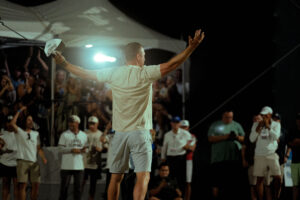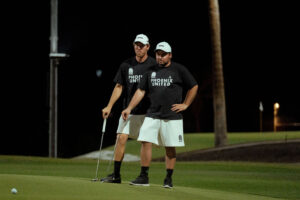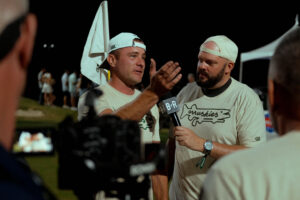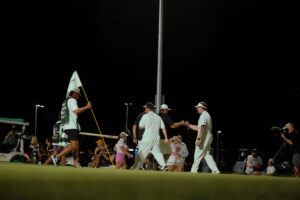- Slug: Sports-Grass League Golf, 1,540 words.
- 4 photos available (thumbnails, captions below).
By Jack Reeves
Cronkite News
TEMPE – The World Series, Super Bowl, World Cup, Olympics, and the Rose Bowl all have something in common. Yes, they are among the world’s most famous sporting events, but one unique feature ties them together: each event is played under the lights.
While that may seem obvious, not all sporting events benefit from playing under the lights, especially in golf. Countless golf tournaments have been postponed due to darkness, requiring an early morning finish. But what if there was a way to play not just a few extra holes, but an entire round during primetime hours?
Enter the Grass League. Established in February, the startup league has brought a new vision to the game loved worldwide.
The Grass League is a high-stakes, par-3 golf league played at night under the lights. The league currently consists of 10 teams, 18-hole rounds, but only par-3s, making for a high level of action and excitement.
The team behind Grass Clippings envisioned taking their venture to a new level, one never seen in the game of golf. The league isn’t limited to strictly professional events or players. Instead, the league’s founders had a vision beyond professionals to tap into a world of talent that doesn’t receive the same recognition or opportunity.
“Something that was lacking in Arizona was competitive amateur golf,” Grass League co-founder Pete Wilson said. “There’s this dynamic when you go to places like Minnesota, or the South in Georgia, and you find these amateur golf tournaments that the town shuts down for and galvanizes the community. People and kids look up to that opportunity of potentially winning that someday.”
The new league engages golfers who have the skill set to compete at the highest level but, for a variety of reasons, haven’t made it.
Wilson and his co-founders – Jake Hoselton, Jimmy Hoselton and Connor Riley – initially started the idea on a much smaller scale. Unlike the normal individual stroke play format played in professional golf, they changed the structure in effort to get everyone involved.
The scramble format allows every golfer to compete.
“We thought to ourselves, ‘A par-3 course, two-man scramble,’” Wilson said. “It was a shot in the dark. But we had a thesis, and we went with it. We ran the tournament at Mountain Shadows, a very well-kept par-3 golf course in Paradise Valley. The response we got was overwhelming.”
The extra nerves were lifted and the buzz around par-3 golf officially commenced in February. The next step was taking it to a big-time course, under the lights.
The structure of the Grass League was built on selling franchises. There are 10 franchises, with teams from cities like Dallas, Tampa Bay, Los Angeles and others. The teams and ownership were structured in a different way than LIV Golf, which is the only other golf league with teams.
Unlike LIV, the owners of the teams do not play for their sides but rather recruit players. Some notable owners are Dave Roberts (LA Roses), Good Good (Dallas Horsemen) and Jermey Davis (Phoenix United).
Davis, who also owns Manor clothing company, put a group together and purchased a team, Phoenix United.
“I think it’s the next generation of golf,” said Davis, who owns Manor clothing company in Phoenix. “I like that it’s open to interpretation as far as uniforms, being yourself out there and just having fun. It’s almost like the 16th hole (Phoenix Open) every hole, simply because every single shot can go in.”
The Grass Clippings Open was the first event held in April. They hosted players from across the country, all competing for their stake in the $100,000 purse.
Tyler Weworski got the invite to join Phoenix United from Davis. Previously, he was one of the many players who pursued the dream of making it to the PGA Tour.
“I’ll be honest, I was the pro who didn’t make it to the big time,” Weworski said. “I was always the guy who was the dreamer or mini-tour guy who wanted to play in front of crowds and never got that chance. That’s what this tournament brought, there’s thousands of people watching. I felt like I was at that next level I was always wanting.”
The tournament had the feeling of a big-time event. On top of the thousands of fans in attendance, Bleacher Report provided coverage that aired on TBS and even HBO Max. For a tournament’s first event, the coverage modeled a PGA tour event.
“That was the most pressure I’ve felt in recent memory,” said Andy Carlton of the Michigan Auto Aces. “We play a lot of money matches. I played in high school and a couple years in college. But I’ve never been a part of anything like that.”
The founders, and even the broadcasters, couldn’t have dreamt of a better finish, which featured a four-team playoff at 14-under. Drew Kittleson drained a birdie putt to give himself and partner Brian Hoops the win, earning the Minnesota Muskies $40,000 in winnings.
“I can’t believe it, I am getting calls from people all over the country,” Wilson recalled Kittleson saying in an interview with Bleacher Report on the 18th hole. “People from Florida where I used to play at Florida State, people back in Minnesota. This is nuts.”
It wasn’t simply the golf that made the event and atmosphere special.
“The tickets were affordable, the food trucks were here, you’re under the lights, you had babies in strollers, and you had college kids,” said Mike Uribe, director of guest services at Grass Clippings. “The nice thing and the beautiful thing that we saw was there is something for everybody, and that’s what we wanted. It’s a plus that we had really good competitive golf and it came down to the wire with the Muskies, that was just the icing on the cake.”
The tournament was a success on all fronts, and the franchise aspect is expected to grow, with more discussions ongoing about new owners in new cities. Each team operates like any traditional American sports team would, as players can be traded and signed throughout the season.
Each franchise will have five two-man teams, three of which will be in the tournament. There will be a qualifier or series of qualifiers before the tournament begins. The team owners will have a draft after the qualifier to fill out the five two-man teams, and each season will end with a championship.
The purse started at $100,000 in the first event, but one can expect that number to increase over future tournaments. However, amateurs are not allowed to make money in professional tournaments. Since January 2022, the USGA allows amateurs to be paid to sponsor products. Wilson and Uribe mentioned how many amateurs who participated in the first tournament have already earned brand deals and sponsorships.
“I’ve seen it a thousand times when a guy comes out of college, has all the talent in the world, and three years into it he gives up,” Wilson said. “Because he’s playing something in Nova Scotia, wins five grand but it took him 10 grand to get there. We thought to ourselves, ‘What if we became this alternative golf model where they can still pursue their professional career, remain amateur, make money through NIL to where they can afford the life they need to go through in professional golf.’”
There are fewer restrictions to play in Grass League, and there are wins for everyone, including the pros, amateurs and fans.
The best players in the world primarily play on the PGA Tour and LIV, and this new team style of golf in primetime is sure to attract the biggest names. In fact, it already has.
“Yes, there is a world where the best players show up,” Wilson said. “We would be very interested to partner with certain golf courses, certain entities that can expand our footprint. We are actively looking for additional sites to really grow this concept around.”
There will always be the PGA Tour and big golf tournaments around the country. But the Grass League is changing the landscape of competitive golf. Not only is it under the lights, but the entire atmosphere around each tournament is giving all the talented players in the world who aren’t on TV a shot while bringing a new demographic of fans into the game.
“I just want golf to be fun for people, welcoming for people,” Uribe said. “For the amateurs who can’t afford it. Who never had these colleges or agents see them, or sponsorships when they were good enough; have access to this now and could make a name for themselves … I think that’s just a piece that we have something special and it’s just the beginning.”
As Uribe said, this is just the beginning for the Grass League, with plans for a much larger impact in the future.
“I see this league going all over the country, honestly,” Weworski said. “I see it being a mixture of amateurs and pros … It’s just a really good vibe that I think the world of golf needs to see. This league just brought everyone together, brought any differences, put them to the side and said let’s play some night golf, let’s have some fun, let’s have some competition.”
For more stories from Cronkite News, visit cronkitenews.azpbs.org.



